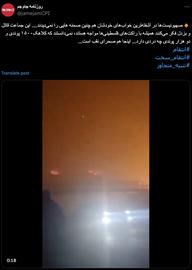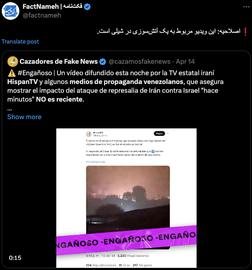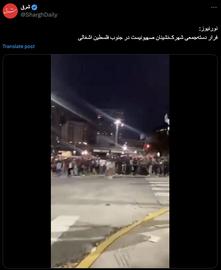Iranwire – The Islamic Republic was not truthful during its “True Promise Operation” against Israel.
Iranian media published a significant amount of inaccurate and false information within less than 24 hours following the IRGC’s drone and missile attack on Israel.
Amid a war of fake news and false narratives, the initial misstep occurred with the IRGC’s first statement.
Released nearly simultaneously with the launch of drones towards Israel, the statement claimed, “It struck specific targets in the occupied territories by launching dozens of missiles and drones.”
This claim, seemingly crafted well before the actual launch of drones and the commencement of the True Promise Operation, strongly emphasized the “successful launch of dozens of missiles and drones.”

Yet, reports confirmed that Iranian projectiles had only reached Israeli territory an hour later.
Additionally, Israeli and American officials said that 99 percent of the IRGC’s fired missiles and drones had been intercepted.
Perhaps recognizing the discrepancy, media outlets aligned with the IRGC, such as Fars and Tasnim news agencies, swiftly amended the IRGC’s statement, removing the section about the drone and missile strikes hitting their intended targets.
The first images of the attack were initially published through government-affiliated social media accounts before being broadcast repeatedly on state TV.
Notably, one of these images purported that IRGC drones and missiles had struck a military base in Negev, Israel.
The published images were actually related to a forest fire in the state of Texas.
Experts highlighted this error, and X (formerly Twitter) added warning messages beneath user accounts that shared this video to depict the IRGC’s attack on Israel. Nonetheless, various news channels and television networks repeatedly aired images of the Texas fire as the actual attack footage.
Additionally, Mehr news agency, Iran newspaper, Tasnim news agency, and several other government-affiliated media outlets published a different video claiming to show the targeting of the Nevatim Airbase in the Negev desert.
However, contrary to their assertion, this video was of a fire that occurred several months earlier in Chile.
Further false information was published by Noornews, a media outlet associated with the Supreme National Security Council, which circulated a video titled “Escape of Zionist Settlers.”
Although this video was removed from the Noornews account on social media, outlets like Shargh continued to feature it.
The pictures mentioned were originally of a gathering of fans of an English singer in Buenos Aires.
Even the official news agency of the Islamic Republic of Iran, IRNA, utilized images from an Arab-speaking user’s social media account in a video report titled “A Decisive Response to the Red Line.”

Moreover, a video portraying the joy of Palestinian people in the Al-Aqsa Mosque was repeatedly broadcast by the official media of the Islamic Republic despite it being initially published on social networks on April 6.
Another misleading video related to Israel depicted the reaction of the Iron Dome to a rocket attack from October 2023
Fars news agencies, Tasnim, Mehr, IRNA, Iranian newspapers, Hamshahri, and others, all incorporated these videos or their combinations into clips relating to the IRGC’s drone and missile attack on Israel despite containing inaccurate or false information.

Simultaneously with the drone and missile attack on Israel, the Islamic Republic heightened its control over the media and social networks.
The IRGC issued threats against social media users expressing support for Israel.
Their announcement urged citizens to report any online activity backing the Israeli government.
Additionally, the IRGC warned that pages “accompanying and supporting” Israel would be closely monitored and addressed accordingly.
Within an hour of this announcement, the Tehran Prosecutor’s Office alleged that a media outlet and an economic reporter had committed a crime. However, the specifics of the charges were not provided.
According to the Judiciary of the Islamic Republic, the content published by this media entity aimed to “disrupt the psychological security of society and destabilize the country’s economic atmosphere.”
The Jehan Sanat newspaper featured an article titled “Media Bombing of Markets: Stock Market Collapse After the Political Earthquake,” analyzing the potential financial repercussions of escalating tensions between Iran and Israel.
Shortly after, the Tehran Prosecutor’s Office announced criminal charges against the newspaper Etemad and its journalist Abbas Abdi.
The judiciary called for the editor-in-chief of Etemad and Abbas Abdi to provide explanations, citing their actions as undermining “the psychological security of society.”
In a note published in Etemad, Abbas Abdi expressed his belief that Israel’s attack was primarily a reaction and did not necessitate a response from Iran.
He further emphasized the futility of conventional weapons against a nation that denies Iran’s existence or seeks its destruction.
The Islamic Republic has a long history of disseminating exaggerated narratives.
After the attack on the Al-Asad base in Iraq in 2020, its propaganda machinery also propagated exaggerated accounts of the casualties among American soldiers.
Following US President Donald Trump’s order to assassinate Qassem Soleimani, the commander of the IRGC Quds Force near Baghdad airport, the Islamic Republic announced its retaliatory strike on two Iraqi bases housing US military forces.
An hour after the attack, the US Department of Defense confirmed that more than a dozen missiles had been launched at the Al-Asad base and another base in Erbil.
Over the years, the Islamic Republic has persistently clung to such narratives without providing substantiating evidence.
In the recent drone and missile attack on Israel, it appears that the Islamic Republic is attempting to suppress the publication of genuine news related to the attack by levying charges against individuals and media outlets.
Through this method, the Islamic Republic appears to be hoping to gain an advantage in the battle of “narratives.”
 Shabtabnews In this dark night, I have lost my way – Arise from a corner, oh you the star of guidance.
Shabtabnews In this dark night, I have lost my way – Arise from a corner, oh you the star of guidance.



